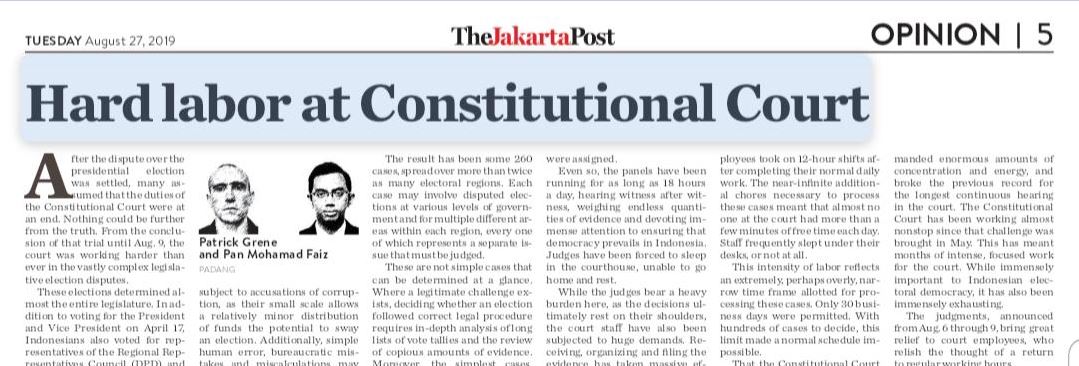The Courtesy of the Court
For the past couple of weeks I have been working at the Constitutional Court of the Republic of Indonesia, in Bahasa, the Mahkamah Konstitusi Republik Indonesia. I have been welcomed with incredible generosity and given utmost care by the officials and staff of the court. The hospitality I have been shown is especially striking given the current demands on these individuals’ time, demands that are currently truly extraordinary.
While the dispute over the presidential elections has now been resolved in the Constitutional Court, this has not brought anything resembling an end to the work here. The presidential controversy was, of course, exceptionally high-profile, with public attention focused on the decisions and processes of the court. With the scent of violence and public disorder still lingering in the air, there was palpable tension around the Constitutional Court during the course of this case. Now that this dispute has been decided, and allegations of subversion of democracy largely dismissed on both sides, a sense of anticlimax defines the national mood.
However, in the wake of the case over the presidential election has come a slew of cases over the legislative elections, held concurrently with the presidential election. These elections included almost the entire legislature, at three levels. In addition to voting for the President and Vice President, on April 17 Indonesians also voted for representatives for the DPD, the Regional Representative Council which represents the higher legislature and the DPR, or People's Representative Council, the lower legislature. They also voted for lower, regional bodies, electing councillors for provincial, district or regency, and borough or municipal councils, altogether the DPRD, which includes, in various divisions, these lesser bodies). Hundreds of thousands of candidates competed for tens of thousands of seats.
A considerable amount of controversy is involved in much of the Indonesian electoral process, where ‘money politics’, or vote-buying, all too often runs rife, especially at the lower levels of government, where scrutiny of individual elections is necessarily likely to be less prevalent than at higher levels. Additionally, the sheer number of concurrent elections here made oversight exponentially more difficult, with the hard-fought presidential election demanding a disproportionate degree of scrutiny. As a result, the possibility of corruption was necessarily quite high, although the numerous processes that the Indonesian government has established to mitigate corruptive influences undoubtedly reduced this considerably. Such corruption, of course, also arrives atop the obvious potential for bureaucratic mistakes, miscalculations, and general human error that comes with such a vast number of elections, with such a huge populace, in such an enormous territory.
There remained, therefore, numerous grounds on which individual election results could legitimately be challenged. Additionally, those who lost fairly but retained a sufficient campaign purse to mount a legal challenge may have found the urge to try their chances in a court too tempting to pass up. While the court process comes with costs that might prevent minor parties with minimal funds from lobbying challenges on grounds based more on hope than belief, larger and better-funded parties can frequently afford efforts in this direction. This has been made clear by the hundreds of cases presented to the Constitutional Court, each of which represents the contestations of a particular political party in one of Indonesia’s 34 regions and comprises numerous challenges to various sundry elections.
These cases, moreover, come to the court after a winnowing process through BAWASLU, the body appointed to deal directly with such controversies as they arise. BAWASLU maintains its own internal court apparatus, which gives speedy decisions based on a trial that is limited to 14 days, and that rapidly percolates through BAWASLU’s executive authority and interwoven connection with the Indonesian police force. The cases that have proceeded to the Constitutional Court are those too knotty to admit easy resolution by BAWASLU, demanding a deeper analysis or a higher level of authority to resolve.
The Constitutional Court is thus deeply swamped, with boxes of evidence mounting in endless piles, filling rooms that would otherwise house the offices of judges or researchers, cluttering up the evidence halls, and liberally coating the desks of those appointed to wrangle this electoral hydra into submission. The court itself has been divided into three separate sessions running concurrently, the nine judges divided accordingly, with day after endless day devoted to the contemplation and interpretation of facts and figures from Aceh to Papua. Extra typists have been hired to take on the task of contemporaneous transcription, and even with their help, my colleagues have 12-hour night shifts on top of their daily responsibilities to try to deal with the seemingly endless demands of the trials.
That my hosts can and do spare the time and energy to provide me with their assistance and advice, to set up meetings with the judges and researchers, and to greet me consistently with warmth and welcome, is truly extraordinary, and demands my deep gratitude and profound respect.

***An article I wrote describing the remarkable fortitude shown by the Constitutional Court team was subsequently published in the Jakarta Post, and is available online: https://www.thejakartapost.com/news/2019/08/27/hard-labor-constitutional-court.html